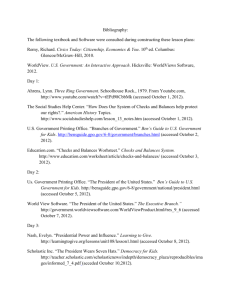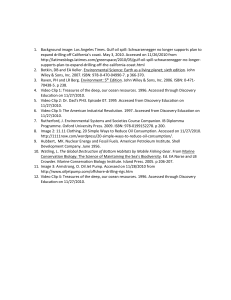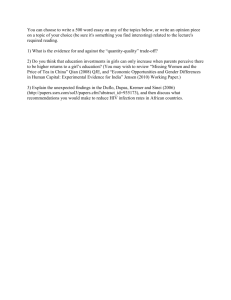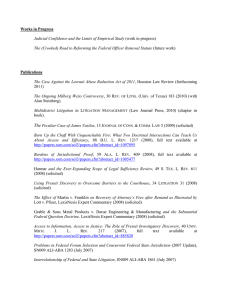The crisis of the US automobile industry
advertisement
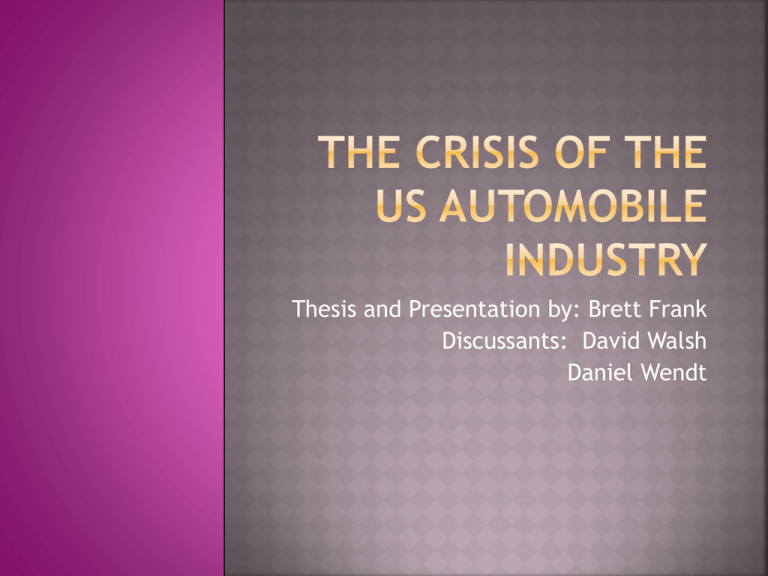
Thesis and Presentation by: Brett Frank Discussants: David Walsh Daniel Wendt What was the true cause of the United States automobile crisis? How does the auto industry plan to strengthen its long term competitiveness? 10 sources Heterodox theoretical approach Historical narrative beginning at the inception of the “Big 3” to present time What are the industry’s plans for regaining a larger market share The dominance of the “Big 3” peaked in 1955 with a market share of 94.5% Market share now hovers around 50% The woes of the auto industry are second only to the financial industry. Chrysler and GM deemed too big to fail Legacy costs Source: Klier, Thomas. "From tail fins to hybrids: How Detroit lost its dominance." 33 (2009), http://papers.ssrn.com/sol3/papers.cfm?abstract_id=14065 50 (accessed March 13, 2013). The United States automobile industry crisis was not solely due to the financial meltdown, it was also due to unsuccessful strategic choices to maximize profits in an increasingly competitive global market. Demand shift and uncertain energy policy Legacy costs Subpar quality and lackluster cars Global slowdown Source: Klier, Thomas. "From tail fins to hybrids: How Detroit lost its dominance." 33 (2009), http://papers.ssrn.com/sol3/papers.cfm?abstract_id=14065 50 (accessed March 13, 2013). Source: Klier, Thomas. "From tail fins to hybrids: How Detroit lost its dominance." 33 (2009), http://papers.ssrn.com/sol3/papers.cfm?abstract_id=14065 50 (accessed March 13, 2013). Path breaking contracts with the UAW Better product portfolio Improvements in quality, reliability, and productivity “Big Three” is now the “Detroit Three” Car makers should remain “disciplined” and not get ahead of themselves in terms of production. Another concern is a rise recently in risky borrowers getting approval for car loans. Blinder, Alan and Mark Zandi. "How the Great Recession." 1 (2010), http://facstaff.buffalostate.edu/kasperv/cgi-bin/pwd.pl (accessed March 4, 2013). Brunel, Claire and Gary Clyde Hufbauer. "Money for the Auto Industry:." (2009), 4.pdf (accessed March 13, 2013). Gramlich, Jacob. "Gas Prices and Endogenous Product Selection in the U.S." 1 (2008), http://128.36.236.74/seminars/apmicro/am08/gramlich-081216.pdf (accessed March 13, 2013). Haugh, David, Annabelle Mourougane and Olivier Chatal. "The Automobile Industry in And Beyond The Crisis." OECD Economics Department 745 (2010), http://cid.bcrp.gob.pe/biblio/Papers/OCDE/86280.pdf (accessed March 13, 2013). Helper, Susan, John Paul MacDuffie, Joel Cutcher-Gershenfeld, Teresa Ghilarducci and Thomas Kochan. "Best Options for the Auto Industry Crisis." 1 (2008), http://faculty.weatherhead.case.edu/helper/papers/Best Options for the Auto Industry Crisis 11 20 08.pdf (accessed March 13, 2013). Klier, Thomas. "From tail fins to hybrids: How Detroit lost its dominance." 33 (2009), http://papers.ssrn.com/sol3/papers.cfm?abstract_id=1406550 (accessed March 13, 2013). McAlinden, Sean, Kristin Dziczek and Debra Maranger Menk. "CAR Research Memorandum: The Impact on the U.S. Economy of a Major Contraction of the Detroit Three Automakers." Center For Automotive Research (2008), http://cargrou1.www69.a2hosting.com/assets/files/detroit_three_contraction_impact.pdf (accessed March 13, 2013). Platzer, Michaela and Glennon Harrison. "The U.S. Automotive Industry: National and State Trends in Manufacturing Employment." Cornell University ILR School (2009), http://digitalcommons.ilr.cornell.edu/cgi/viewcontent.cgi?article=1671&context=key_workplace (accessed March 13, 2013). Rosenfeld, Herman. "The North American Auto Industry in Crisis." Relay A Socialist Project Review 26 (2009), http://socialistproject.ca/relay/relay26.pdf Rutenberg, Jim, & Bill, Vlasic. "Chrysler Files to Seek Bankruptcy Protection." NY Times, April 30, 2009, http://www.netadvisor.org/wp-content/uploads/2012/03/2009-04-30-Chrysler-Files-to-Seek-Bankruptcy-Protection-NYT.pdf (accessed March 13, 2013). http://ww.iie.com/publications/pb/pb09-



